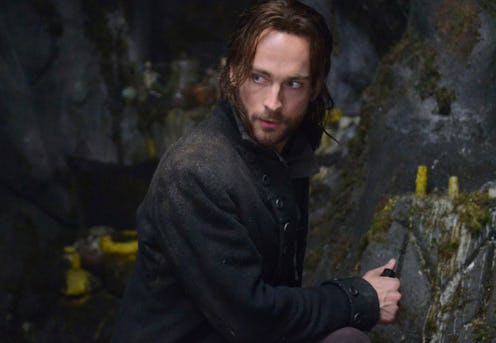
Fox's new crime procedural, Sleepy Hollow, is just as fantastical as you'd imagine. Thanks to a little hocus pocus, Ichabod Crane (Tom Mison) finds himself in modern day Sleepy Hollow where he's immediately blamed for a rash of murders in which the assailant beheads his victims with an ax hot enough to cauterize the wound each time (and keep the series' fake blood budget to a minimum). He teams up with the one person crazy enough to believe him, police lieutenant Abbie Mills (Nicole Beharie) and the duo dive head-first into supernatural action, but their first major act is to completely obliterate the Washington Irving tale on which the series is loosely based. Sorry, literature lovers.
The series is already a bit of a tough pill to swallow; suspending one's disbelief long enough to accept that Ichabod could be buried in a cave for over 200 years and awake alongside the infamous headless horseman because of some mysterious spiritual connection between the two is a tall order. Add to that the wild changes made in the classic American story — and one that most of us had read by age 15 — and Sleepy Hollow has put itself in a bit of an uphill battle.
1. WHAT'S IN A DATE?
Irving's Sleepy Hollow is set in 1790, 14 years after the Revolutionary War. It has been suggested that Irving cast the Headless Horseman as the ghost of a deceased Hessian soldier because during the Revolutionary War, the British soldiers enlisted the help of Hessian Jägers (which literally translates to "hunters," but in practice generally referred German mercenaries).
So, in the story, just 14 years after the war, the "ghost" emerges from the Hessian soldier's eternal slumber, taking aim at Ichabod Crane, the mild-mannered school teacher who hopes to steal the heart of the town's most eligible bachelorette, Katrina.
In Fox's version, Ichabod is a fully-grown, married soldier in the war and the right hand of General George Washington himself. Now, there was a great deal of fighting that happened in Westchester county, so that's not the issue, nor is the idea that Washington would have had a right hand man. However, this version screws with Irving's story because Ichabod is struck down and buried in 1776, long before the 1790 date of the classic story.
2. IS THAT REALLY YOU, ICHABOD?
Let's get one thing straight: in the original tale, Ichabod is an extremely mild-mannered gawky school teacher from Connecticut. He even plans to ask for Katrina's hand in marriage at the end of a party, after everyone has gone and winds up missing his chance. Later, Brom Bones, his romantic rival, marries Katrina and Ichabod mysteriously disappears. At the time (1790), Katrina is 18-years-old and Ichabod is supposed to be a bit older. For reference, that means that in 1776, Katrina was 4-years-old.
Over in Fox's imaginationland, Katrina is far older than 18 when, in 1776, she buries her dying husband Ichabod after he fights with the soldier who would become the Headless Horseman. Everything that happened in Irving's story is immediately made impossible, including the part where Ichabod loses his lady love. His "mysterious" disappearance, however, remains, though instead of people supposing he was dispatched by the Headless Horseman (who may or may not be Brom in disguise), he's laid in a well-hidden cavern that looks like it was ripped from a pirate story.
To boot, Mison's Ichabod is far more dashing and daring than any Ichabod in the history of time (and that includes Johnny Depp's fumbling scholar in Tim Burton's rendition of the tale) because he's a revolutionary soldier and not a woebegone school teacher. In all fairness, Irving did pull the character's name from a military officer he knew from Staten Island, so perhaps there is some justification in making Ichabod a soldier for Washington — the reverse argument, however, is that the actual character was based on a local teacher named Jesse Merwin and that the real Crane was nothing more than a namesake.
3. THE HEADLESS HORSEMAN'S SECOND CALLING
Originally, the Headless Horseman is — as I've said — the ghost of a Hessian soldier and later suggested to be Brom playing an elaborate hoax on his romantic rival. On Fox, however, the soldier without a head is said to be one of the four horsemen of the apocalypse, searching for his long-lost skull so he can become whole and thus summon the rest of his evil quartet. He also manages to drop his ax and pick up a submachine gun and yards of ammunition like some sort of Revolutionary War Rambo by the time the action really ramps up.
Ichabod is linked to the Horseman (we'll leave the how and why to the series itself, should you decide to watch) and Abbie is linked to Ichabod due to matching visions of evil they both happened to encounter, hundreds of years apart. Thus, Ichabod, the not-so-mild-mannered protagonist of Irving's classic tale was not fated to disappear into the night after being tormented by a ghost in 1790s Westchester County, but rather to be buried and like Brendan Fraser's Encino Man, emerge unscathed one fateful day so that he might team up with his own Polly Shore (though, to be fair, Abbie is beyond preferable to the whack-job comedian).
Basically, the lead character's name is the same, there's a violent headless assailant riding a horse with crimson eyes, and the tone is unequivocally spooky (the sky is red or orange in almost every single scene), but Fox's new series barely resembles the story we grew up with.
Then again, if you're going to bring Ichabod Crane to 2013 and have him star in a crime procedural, you're going to have to chop off a few figurative heads to make it work.
[Image: Fox]